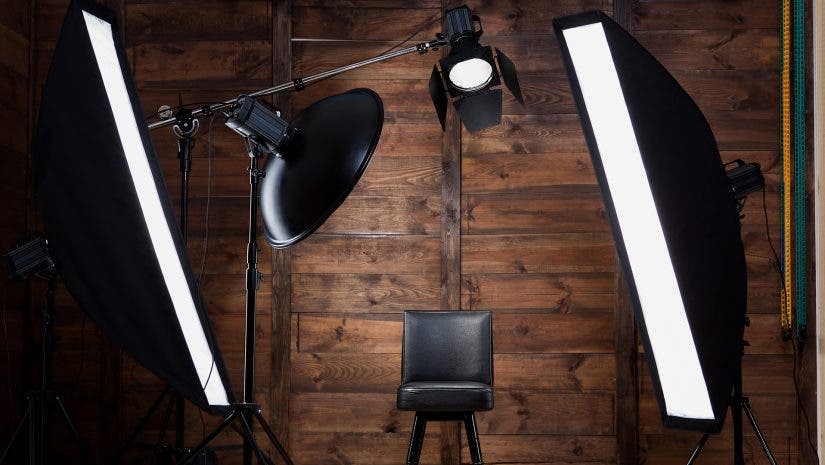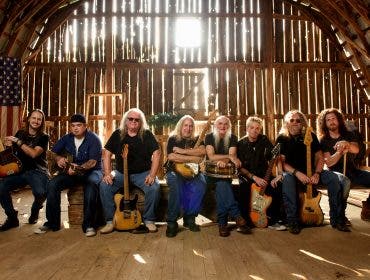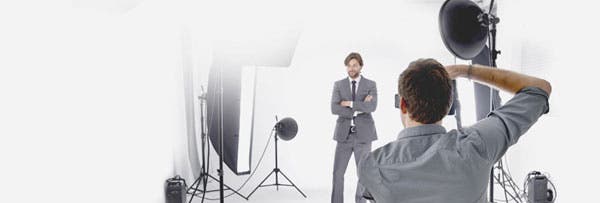Photographing a subject with straight artificial light can make for a very harsh result. It will often show every blemish, every pore and create severely harsh shadows. This is where light modifiers come in. There are umbrellas, softboxes, beauty dishes, barndoors, snoots and many other modifiers that help to shape and soften light. While there are many light modifying tools out there, a softbox is probably the one tool with the most variations be it size, shape, color and way to be used. Whether using continuous lighting, speedlights or strobes, softboxes prove to be one of the best light shaping tools for any professional photographer’s to have in their toolbox. Here we’ll examine what they are and what they can do.

What is a Softbox?
A softbox is a tool that just about every professional photographer has some form of in their light modifier arsenal. It provides directional light at a subject allowing for very soft to slightly harsh shadows to appear depending on the size of the softbox. Softboxes are made to take a light source, bounce its light all around the interior of the box and to shoot the light through the front diffusion panel without any light spill through the sides or back of it. How does this work?
Construction
The construction of a softbox is nothing short of a box made of black cloth, inner lined with opaque silver or white material, shaped by wire/fiberglass spokes and covered with a white front diffusion panel. They oftentimes have an inner baffle that serves as a second layer of diffusion.

- Outside Cover. The black outside cover fabric serves to help contain the light within the box so that it only exits at its opening.
- Inner Lining – the inner lining is white, gold or silver material inside the black cover that serves as a reflector for the light source.
- Inner Baffle – the inner layer of white diffusion material that softens the light from a light source and helps to spread it evenly to the front diffusion panel to avoid hot (or bright) spots in its center. Inner baffles are typically found on larger softboxes.
- Diffusion Panel – the outer layer of white diffusion material found on the face, or opening, of every softbox that serves to soften the harsh direct light produced by a light source.
Softbox Construction Types
There are generally two different softbox construction attachment types: 1) those set up to unfold and to be attached to the light source like an umbrella and 2) those that you manually have to put together using a speed ring and wire/fiberglass spokes where the softbox is attached by the speed ring.
Umbrella-Constructed Softboxes
I personally love umbrella-constructed softboxes as they easily open and attach to a light source just like an umbrella. Once the umbrella is opened, its shaft is inserted either into the light stand adapter for speedlights and certain strobes or for some strobes – into the strobe head unit itself. The Westcott 43” Apollo Orb is my favorite umbrella type softbox as it’s a larger softbox, opens easily like an umbrella and is easy to attach to a light stand or strobe head.
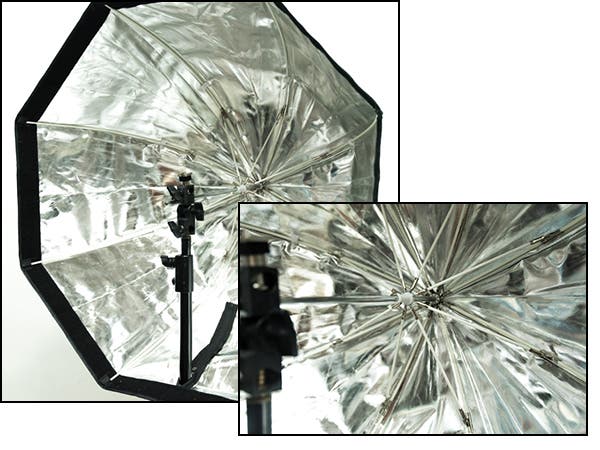
Most softboxes that work through an umbrella type attachment often have the light source facing into the softbox with its light bouncing directly into the back of the softbox and reflects back out of the diffusion panel in the front.
Speedring-Constructed Softboxes
Speedring-constructed softboxes are a more common type of construction and depending on the brand, can be a little more work to put together. These types of softboxes require between 4-8 spokes to be placed into notches located in the inner edges of the softbox cover and then stretched to work into the grooves of the outside edges of a speedring which will be placed in the center of the softbox. The softbox cover center edges are then pulled up and around the speed ring and velcroed together. Believe me when I say this, this can oftentimes be a workout with less-expensive, off-brand softboxes so spend the few extra bucks for a brand name softbox.

Sometimes you’ll find a combination setup such as the one below. Here, the softbox opens like an umbrella but the spokes come automatically attached to the speedring.

Speedring-attached boxes generally have the light poking into the softbox from the backside of the softbox and the light shines directly out through the front. With these types of softboxes, an inner baffle is often needed to break up the light to diffuse evenly across the subject rather than that type of setup of the softbox allowing a hot spot to be produced in the center.
Softbox or Umbrella? The Pros and Cons
Umbrellas
Umbrellas can be found in the toolkit of any photographer from a beginning amateur to an advanced professional. They are a forgiving light modifier for the beginner but when used with the proper know-how, can be an asset to even the most advanced photographer. Below are some of the pros and cons of using umbrellas in photography.

Westcott 7-foot Parabolic 3-Umbrella Kit
| Pros | Cons |
|
|
Softboxes
Softboxes are one of the most common tools you will find in a photographer’s tool kit. Why? Because it can take harsh light and soften it like butter. It can also take uncontrolled light and allow it to be not only controlled, but directed at only your subject instead of spilling all over the room. Below are some of the pros and cons of softbox usage.

| Pros | Cons |
|
|
Shapes
The shape of the softbox used in people lighting can make a big difference in the success of the results. Softboxes usually come in the shape of squares, rectangles, long rectangles (strips) and octagons (octaboxes a/k/a octabanks).
Squares and Rectangles
Squares and rectangles work well as main light sources as well as a fill lights. Depending on their size, they tend to throw out a more defined light complete with a nice and soft transitioning of shadows.

Contrary to some preferences, I find squares to make interesting and dynamic catchlights in the eyes when used in conjunction with a circular or triangular reflector as shown below.

Strips
Strip softboxes are great for lighting the full body when placed parallel with a subject. They also work well as hair lights.

Depending on the distance from the subject, strip softboxes can create a very subtle or a very harsh transitioning in shadows.

Octaboxes
Octaboxes, sometimes called octabanks, make for wonderful key lights. Their round shape is similar to the sun and the catchlights produced by round softboxes can be much more pleasing to some as they cast a more natural round catchlight into a subject’s eyes to match the roundness of their pupils.

An octabox tends to wrap light around its subject. I find a larger octabox placed close to my subjects face serves close to what a beauty dish would do for me when placed straight in front of my subject. When placed anywhere else, shadows can vary from subtle to harsh depending on the proximity to the subject.
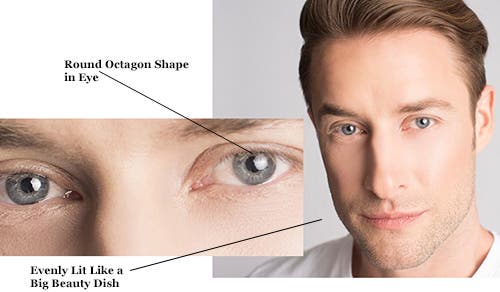
Fun With Softboxes
Since softboxes create more directional light, sometimes you can use them to create interesting effects. In the image below, I had my subject look directly into a strip softbox to create a cat-like look in her eyes as the reflection of the strip was positioned perfectly in the center of her pupils.

In people photography, a tipoff to the positioning of the light source and what type of light modifier was used to produce an image is usually evident in the catchlights in the eyes of the subject. Softboxes are no different and, when they actually are in play, one can determine the shape of the softbox being used and its distance from the subject by the size and shape of the catchlights in the eyes.
Sizes
Not only do softboxes vary in shapes, but they also come in various different sizes from small basketball-sized softboxes to large wall-sized softboxes. Which one to use depends on the result you are going after.

The larger the softbox, the softer the light and the lesser defined shadows. Insert a white lining and an inner baffle and the light gets even softer. As you step down in size, the harsher and more defined shadows will become on your subject.
Accessories
For Speedlight Use
- Speedlight Adapter w/ Umbrella Holder

JTL Adjustable Adapter w/ Umbrella Holder
- Speedlights – There are many speedlights to choose from depending on your camera brand and what will work with it. I share a lot of information and recommendations on speedlights in my series article: Building the Home Studio Part 3: Flashes, Light Meters and Backgrounds.

For Strobe Use
- Strobes – There are also hundreds of strobes to choose from, too many that I’m not going to recommend any here, but be on the lookout for my upcoming article on Building the Home Studio Part 5 in June 2016 involving strobes for more advice on picking out a strobe that is right for you.

For Speedlight or Strobe Use
- Lightstand
There are also many choices for light stands, however, I go into great depth on how to choose a light stand that will work for you in my previous article: Building the Home Studio Part 2: Continuous Lights and Light Stands.
- Sandbags
Other Accessories
Eggcrates/Grids
Eggcrates and grids are known to narrow and give more direction to the light emitting from the softbox.

Image courtesy of Adorama
Louvers
Louvers are a great tool to distribute light evenly across your subject while helping to eliminate spill of light onto the background.

Image courtesy of Adorama
Masks
Masking strips are a fun creative tool that allow you to play with the light emitting from your light source such as creating the effect of daylight coming in through mini blinds.

Lastolite 24”Ezybox Hotshoe Creative Masking Strips
Image courtesy of Adorama
What It All Boils Down To…
There are dozens of manufacturers out there that make softboxes so it can be a bit of decision to make on which one. I can tell you I’m a huge fan of Westcott and Profoto softboxes because I need something a bit easier to put together and I don’t mind spending the extra few dollars for ease of use, but that is just my personal preference. Think on what you will shoot, how you want to shoot it, how much space you have to shoot in and the end results and effects you would like to create. Do you have time to put together a softbox for a shoot or do you need something quick and easy? How much can you afford? Answer these questions, reread this article and research some of Adorama’s softboxes to find the softboxes that are right for you.
